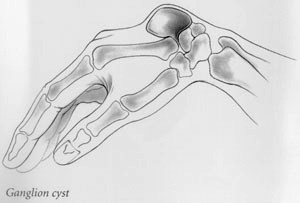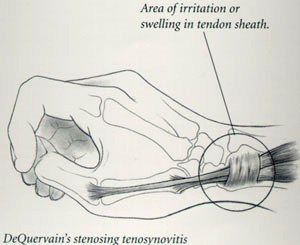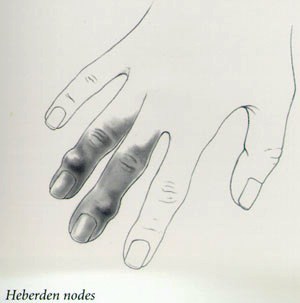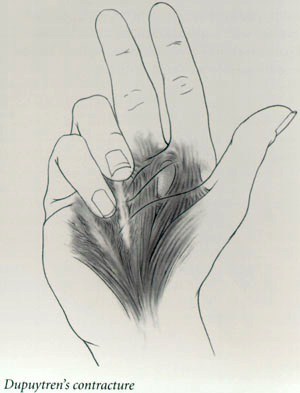No matter what your age or occupation your hands are always working. Since your hands are so important any abnormality can be a cause for concern. Many common hand problems that interfere with your daily activities can be diagnosed and treated by your orthopedic surgeon.
Ganglion Cysts
 Ganglion cysts are the most common mass or lump in the hand. They are most common on the back of the wrist. These non-cancerous, fluid-filled cysts arise from the ligaments, joint linings, or tendon sheaths when they are irritated or inflamed.
Ganglion cysts are the most common mass or lump in the hand. They are most common on the back of the wrist. These non-cancerous, fluid-filled cysts arise from the ligaments, joint linings, or tendon sheaths when they are irritated or inflamed.
They may disappear or change size quickly. Many ganglion cysts do not require treatment.
However, if the cyst is painful, interferes with function or the patient does not like the appearance, your orthopaedic surgeon can remove the fluid with a needle (aspiration) or remove it surgically.
Carpal Tunnel Syndrome
 Common symptoms of carpal tunnel syndrome are numbness and tingling in the hand, especially at night; pain with prolonged gripping such as holding a steering wheel; or clumsiness in handling objects. Sometimes the pain can go all the way up to the shoulder.
Common symptoms of carpal tunnel syndrome are numbness and tingling in the hand, especially at night; pain with prolonged gripping such as holding a steering wheel; or clumsiness in handling objects. Sometimes the pain can go all the way up to the shoulder.
These symptoms are caused by pressure on the median nerve as it enters the hand through a tunnel in the wrist. The tendons that bend your fingers and thumb also travel in this tunnel.
Mild cases can be treated with a splint or brace to rest the wrist. Steroid injections into the carpal canal to decrease swelling may be used in addition to splinting.
Those cases that do not respond to nonsurgical treatment and those that are diagnosed late often require surgery. This is generally done in an outpatient setting under local anesthesia.
Tendonitis of the Wrist
 DeQuervain’s stenosing tenosynovitis is an irritation and swelling of the sheath or tunnel which surrounds the thumb tendons as they pass from the wrist to the thumb. Pain when grasping or pinching and tenderness over the tunnel are the most common symptoms.
DeQuervain’s stenosing tenosynovitis is an irritation and swelling of the sheath or tunnel which surrounds the thumb tendons as they pass from the wrist to the thumb. Pain when grasping or pinching and tenderness over the tunnel are the most common symptoms.
Sometimes a lump or thickening can be felt in this area. If the hand is made into a fist with the thumb “tucked in” and bent towards the little finger, the pain gets worse (Finkelstein test).
Tendonitis may be caused by overuse and also can be seen in association with pregnancy or inflammatory arthritis such as rheumatoid disease.
If treated early, many cases improve with short periods of rest in a splint, followed by stretching exercises designed to get the tendons gliding. Injection with steroids and/or taking anti-inflammatory medications. More severe cases or those that do not respond to other treatment may require surgery.
Modification of the activities which caused the symptoms initially also may be required.
“Wear and Tear” Arthritis of the Hand
 Wear and tear arthritis is very common at the base of the thumb. Pain localized to the base of the thumb, particularly with use, is a very common early symptom.
Wear and tear arthritis is very common at the base of the thumb. Pain localized to the base of the thumb, particularly with use, is a very common early symptom.
Early disease can be treated with anti-inflammatory medication, steroid injections into the joint, or splinting.
As the wear and deformity progress, surgery is frequently required. There are many procedures to relieve pain and improve function.
Heberden nodes are “bumps” which occur at the last joint of the finger or thumb due to wear and tear arthritis (osteoarthritis). As the joints deteriorate, small bone spurs form over the back of the joints and make them appear “lumpy.”
Since most Heberden nodes are not painful and seldom interfere with function, no specific treatment is usually required. Patients with pain can be treated with anti-inflammatory medications. All patients should continue moving their hands; disuse frequently results in stiffness.
Dupuytren’s Contracture
 Dupuytren’s contracture is a hereditary thickening of the tough tissue called fascia that lies just below the skin of your palm.
Dupuytren’s contracture is a hereditary thickening of the tough tissue called fascia that lies just below the skin of your palm.
This condition may vary from small lumps or bands to very thick bands which may eventually pull the fingers into the palm.
Dupuytren’s disease is familial, and may be associated with cigarette smoking, vascular disease, epilepsy, and diabetes.
The mainstay of treatment is surgical and is recommended if there is progressive contracture drawing the fingers into the hand. Sometimes a steriod injection will be used in a painful nodule. Small nodules or lumps in the palm do not need treatment until they are very large and interfere with hand function. Even with successful surgical removal, the bands may reappear or occur in other fingers.
Trigger Finger
 Trigger finger is an irritation of the digital sheath which surrounds the flexor tendons. When the tendon sheath becomes thickened or swollen it pinches the tendon and prevents it from gliding smoothly.
Trigger finger is an irritation of the digital sheath which surrounds the flexor tendons. When the tendon sheath becomes thickened or swollen it pinches the tendon and prevents it from gliding smoothly.
In some cases the tendon catches and then suddenly releases as though a “trigger” were released.
Sometimes the swelling can be treated with rest, activity modification, oral anti-inflammatories, or steroid injections. The tendon sheath will then return to its normal, pain-free condition. More severe cases may require surgery to release the tendon.
This can be done as an outpatient procedure. Normal activity can be resumed as pain allows.
